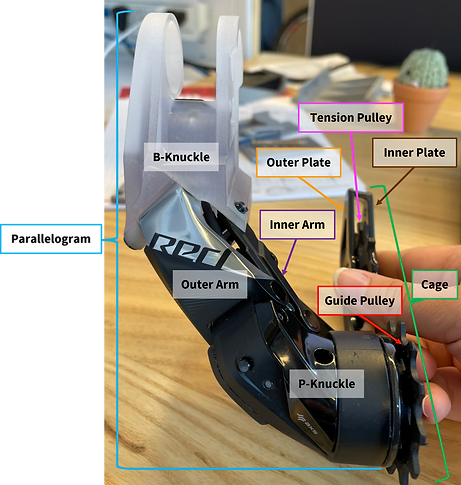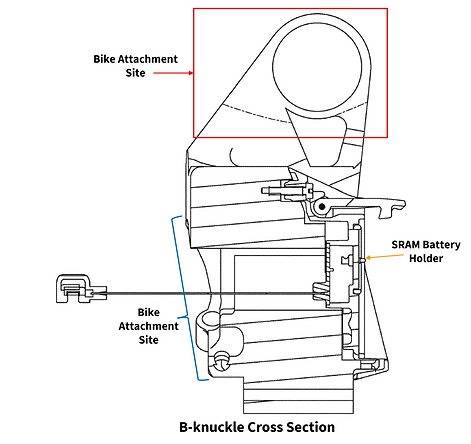SRAM Rear Derailleur
A wireless electric road bike rear derailleur that is coaxially attached to the bike's rear axial.

Summer 2021
Background and Problem
Current road rear derailleurs are attached to the bike frame by derailleur hangers. These hangers are thin and prone to deformation, causing misalignment of the rear derailleur to the cassettes or, in some cases, complete breakage, necessitating replacement.
Requirements
The rear derailleur must:
-
Possess a slanted parallelogram designed specifically for road bikes
-
Be electronically powered
-
Have a stronger and more stable connection to the bike frame
Solution
A road bike rear derailleur that attaches directly to the bike frame and coaxially to the rear axial.
Final Product
A rear derailleur is comprised of multiple parts and can be split up into two big sections: the parallelogram and the cage. The parallelogram contains the b-knuckle, inner and outer arms, and the p-knuckle. The cage contains inner and outer plates, a guide pulley, and a tension pulley.
The components of the parallelogram collaborate to move the cage along a designated path when changing the speed of the bike. Within the cage, the pulleys serve to tension and guide the bike chain during gear shifts.
The main difference between previous SRAM electric road derailleurs and this derailleur is the b-knuckle. The b-knuckle has a bike attachment site, a SRAM battery holder interface, and p-knuckle attachment site.
This road derailleur's b-knuckle has a slanted p-knuckle orientation that is ideal for road bike. The b-knuckle has a hole that starts at the battery holder interface and ends at the p-knuckle attachment site. When powered, the p-knuckle can wirelessly shift the gear speeds.
The biggest addition to the b-knuckle is the bike attachment site and its ability to attach the derailleur directly onto the bike frame. It does this by utilizing a similar coaxial instillation mechanism that SRAM's Universal Derailleur Hanger (UDH) uses to screw onto bike frames. The UDH attachment mechanism relies on the UDH bolt. This bolt is hollowed out and features external reverse threading and regular internal threading. This allows the rear axle to thread into the bolt and the bolt to fasten into the UDH hanger clasping the hanger onto the bike frame. In the b-knuckle, the inner and outer bike attachment sites holds the mechanism to sandwich the derailleur onto the bike frame.
The main difficulty in designing the b-knuckle was finding the distance between the b-knuckle's installation location and the body of the b-knuckle to allow for enough clarence between the derailleur and the bike frame.
Product Description




Outcome
This project resulted in a published patent that can be read here.









